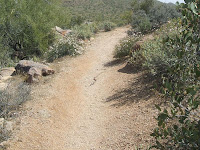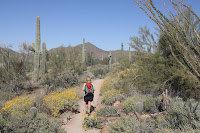For the last 2 days we've started out with good intentions of doing a long hike. Both days saw us getting to Usery Park MUCH later than we had planned causing us to do our standard short hike on the Merkle/Vista Trail. Yesterday we did the hike in "reverse" by starting on the Vista Trail, going up and over the hills and then returning on the flat Merkle Trail. We were treated to some wildlife on our climb up the first hill. A snake sitting in the middle of the trail scooted off before we got any good closeup pictures. We're not sure what kind of snake but it wasn't a rattler. Immediately after that we came across a chuckwalla. Not a creature you're likely to see in the "cute and cuddly" section of the zoo! On the hike today, going out on the Merkle Trail and then up and over on the Vista Trail, we only saw small lizards and, of course, the bees flying in and out of the hive at the top of the trail. One of the joys of hiking is that you can hike the same trail over and over and, if you keep your eyes open, see something new every time.
Tuesday, March 31, 2009
Wednesday, March 18, 2009
Another Snakey Hike
Today we went hiking at Usery Park on the west side of the Pass Mountain Trail. Hoping for a repeat of the rattlesnake sightings, Ross has been carrying his Canon XTi DSLR camera on our last couple of hikes. Today it paid off when Karen spotted a snake just leaving the trail. It turned out to be a beautiful bullsnake. This one was about 4' long. Bullsnakes are non-poisonous but can imitate rattlesnakes when feeling threatened. This one didn't do anything but pose for a few pictures and then slither away.
Monday, March 16, 2009
HDR Photography
My friend Don Stedman introduced me to HDR (high dynamic range) photography. It's a method of handling photographs with different exposure elements. For example, you might have a scene where a regular photo would have part of the picture exposed correctly but another part would be over or under exposed. In HDR photography you take multiple (3 in my case) exposures of the same scene. One is normally exposed, one is under exposed and the last over exposed. Using HDR software you combine the 3 to produce a photograph that has all parts correctly exposed. The results can be quite striking! Below is a somewhat less than dramatic example but it does show how HDR photography works.
Ross
Ross
 | Scene normally exposed. |
 | Scene under exposed. |
 | Scene over exposed. |
 | Output of combined photography from HDR software. |
Monday, March 9, 2009
Snake!
We were hiking in Usery Park last week with Ross's sister Lee who was in town for a visit. Karen spotted a rattlesnake crossing the trail in front of us! This was the first rattlesnake we've ever seen here in Arizona. A couple of days later we were hiking in the McDowell Sonoran Preserve. Lee had turned back early so we were alone on the trail. Ross was behind Karen when he spotted a rattlesnake crossing the trail only about 20' ahead of us! He shouted "stop, stop, stop" and Karen stopped in time. The snake was moving fairly slowly most likely because it had just "woken up" from hibernating. The snake must not have felt threatened because it never shook it's rattle. Ross got a few pictures of it with a spare point and shoot camera he carries in his pack. Unfortunately he didn't have his DSLR camera with him. He didn't get any closer than about 10' from the snake. This snake, a western diamondback rattlesnake, was about 3' long.
 | The snake crossing the trail. |
 | Closeup of the snake with it's head raised from about 10' away. That was more than close enough! |
Subscribe to:
Comments (Atom)









